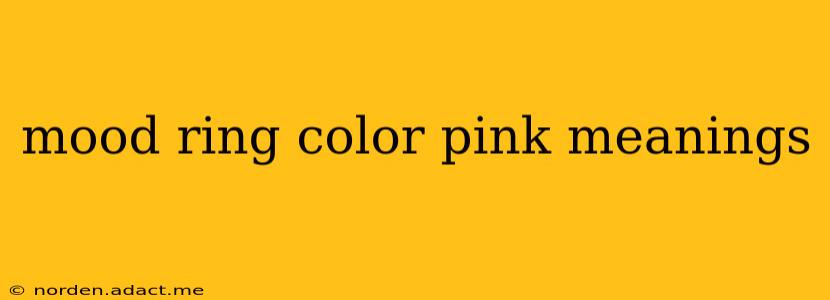Mood rings, those captivating pieces of jewelry that supposedly reflect your emotional state through color changes, have fascinated people for decades. While their scientific accuracy is debated, their allure remains undeniable. This article delves into the meanings associated with pink hues in mood rings, exploring the nuances of this often-misunderstood color shift. We'll also address common questions surrounding these intriguing accessories.
What Does Pink Mean on a Mood Ring?
Generally, a pink hue on a mood ring is interpreted as signifying calmness, peace, and contentment. It suggests a relaxed and tranquil emotional state, free from significant stress or anxiety. Think of the gentle, soothing feeling associated with a serene sunset or a blooming rose – that's the emotional vibe often linked to pink. However, the shade of pink can subtly alter the interpretation. A light, pastel pink might indicate a more delicate sense of peace, whereas a deeper, rose-pink could suggest a more passionate yet still calm emotional state.
Does the Shade of Pink Matter in Mood Ring Readings?
Yes, absolutely! While the general association of pink with calm remains, the specific shade can add layers of meaning. For example:
-
Light Pink/Rose Quartz Pink: This softer shade often points to feelings of gentleness, compassion, and unconditional love. It could represent a peaceful connection with others or a sense of self-love and acceptance.
-
Hot Pink/Fuchsia Pink: A bolder, brighter pink might signify a more energetic, passionate calmness. It could indicate contentment mixed with excitement or a feeling of joyful serenity.
It's important to remember that these are interpretations, not definitive statements. Mood rings are not precision instruments, and individual experiences will vary.
What Other Colors Might I See on My Mood Ring?
Mood rings typically display a range of colors, each associated with a different emotional state. Common colors and their general interpretations include:
- Black: Stress, anxiety, or negativity.
- Brown: Fatigue, exhaustion, or low energy levels.
- Gray: Indecisiveness, uncertainty, or feeling neutral.
- Blue: Calmness, relaxation, or contentment (often a different shade than pink).
- Green: Balance, harmony, or a sense of well-being.
- Purple/Violet: Creativity, intuition, or heightened sensitivity.
Are Mood Rings Scientifically Accurate?
The science behind mood rings is questionable. They function based on thermochromic liquid crystals that change color in response to temperature fluctuations. While your body temperature can be influenced by emotions, the correlation isn't direct enough for mood rings to provide accurate emotional readings. They are more accurately described as temperature indicators than reliable emotion detectors. The color changes are fascinating and fun, but shouldn't be taken as definitive psychological assessments.
How Accurate Are Mood Ring Readings?
As mentioned above, mood ring readings aren't scientifically accurate in the sense of directly reflecting emotional states. The color shifts are primarily a response to temperature changes on your skin. Factors like ambient temperature, blood flow, and even the materials of the ring itself can affect the displayed color. Consider the readings as a fun, suggestive indicator rather than a precise emotional diagnosis.
How Can I Use My Mood Ring Effectively?
The most effective way to use a mood ring is for fun and self-reflection. Pay attention to the color and consider how it might relate to your current emotional state. It can be a conversation starter and a playful way to connect with yourself and others. However, don't rely on it for serious emotional analysis; consult with a mental health professional for any concerns about your emotional well-being.
In conclusion, while a pink mood ring generally signifies calmness and peace, the shade and your own interpretation play a crucial role. Remember, it's a fun accessory, not a psychological tool. Enjoy the colorful shifts and the playful connection they offer!
